
Lhasa, officially the Chengguan District of Lhasa City, is the inner urban district of Lhasa City, Tibet Autonomous Region, Southwestern China.

Heinrich Harrer was an Austrian SS sergeant, mountaineer, explorer, writer, sportsman, and geographer. He was a member of the four-man climbing team that made the first ascent of the North Face of the Eiger, the "last problem" of the Alps, in July 1938. Harrer and the team flew the Nazi flag atop the mountain. Harrer had joined the Nazi Party shortly after the annexation of Austria in March 1938, and was personally received by Hitler after the climb. A year later in 1939, he and the climbing team went on an expedition to the Indian Himalayas, where they were arrested by British forces because of the outbreak of World War II. He eventually escaped to Tibet, staying there until 1951 and never seeing active combat from that point onwards. He wrote the books Seven Years in Tibet (1952) and The White Spider (1959).

While the Tibetan plateau has been inhabited since pre-historic times, most of Tibet's history went unrecorded until the creation of Tibetan script in the 7th century. Tibetan texts refer to the kingdom of Zhangzhung as the precursor of later Tibetan kingdoms and the originators of the Bon religion. While mythical accounts of early rulers of the Yarlung dynasty exist, historical accounts begin with the introduction of Tibetan script from the unified Tibetan Empire in the 7th century. Following the dissolution of the empire and a period of fragmentation in the 9th-10th centuries, a Buddhist revival in the 10th–12th centuries saw the development of three of the four major schools of Tibetan Buddhism.

The Potala Palace is a dzong fortress in Lhasa, capital of the Tibet Autonomous Region in China. It was the winter palace of the Dalai Lamas from 1649 to 1959, has been a museum since then, and a World Heritage Site since 1994.
The 10th Dalai Lama, Tsultrim Gyatso (full given name Ngawang Lobzang Jampel Tsultrim Gyatso or Tsultrim Gyatso was the 10th Dalai Lama of Tibet, and born in Litang, Kham. He was fully ordained in the Gelug school of Tibetan Buddhism, studied the sutras and tantras, had several students, and rebuilt the Potala Palace.
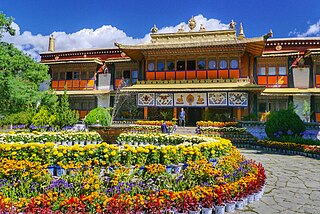
Norbulingka is a palace and surrounding park in Lhasa, China built from 1755. It served as the traditional summer residence of the successive Dalai Lamas from the 1780s up until the 14th Dalai Lama's exile in 1959. Part of the "Historic Ensemble of the Potala Palace", Norbulingka is recognized as a UNESCO World Heritage Site, and was added as an extension of this Historic Ensemble in 2001. It was built by the 7th Dalai Lama and served both as administrative centre and religious centre. It is a unique representation of Tibetan palace architecture.
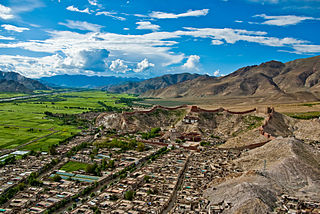
Gyantse, officially Gyangzê Town, is a town located in Gyantse County, Shigatse Prefecture, Tibet Autonomous Region, China. It was historically considered the third largest and most prominent town in the Tibet region, but there are now at least ten larger Tibetan cities.

The British expedition to Tibet, also known as the Younghusband expedition, began in December 1903 and lasted until September 1904. The expedition was effectively a temporary invasion by British Indian Armed Forces under the auspices of the Tibet Frontier Commission, whose purported mission was to establish diplomatic relations and resolve the dispute over the border between Tibet and Sikkim. In the nineteenth century, the British had conquered Burma and Sikkim, with the whole southern flank of Tibet coming under the control of the British Indian Empire. Tibet was ruled by the 13th Dalai Lama under the Ganden Phodrang government as a Himalayan state under the protectorate of the Chinese Qing dynasty until the 1911 Revolution, after which a period of de facto Tibetan independence (1912–1951) followed.
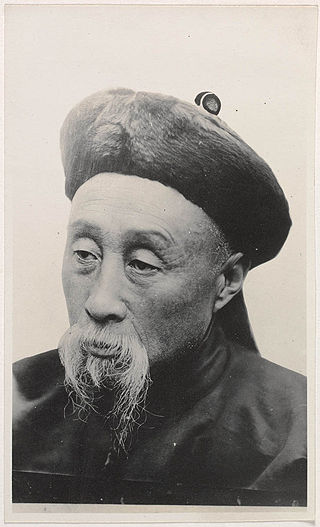
Zhao Erfeng (1845–1911), courtesy name Jihe, was a late Qing Dynasty official and Han Chinese bannerman who belonged to the Plain Blue Banner. He was an assistant amban in Tibet at Chamdo in Kham. He was appointed in March 1908 under Lien Yu, the main amban in Lhasa. Formerly Director-General of the Sichuan-Hubei Railway and acting viceroy of Sichuan province, Zhao was a much-maligned Chinese general of the late imperial era who led military campaigns throughout Kham, earning himself the nickname "the Butcher of Kham" and "Zhao the Butcher".
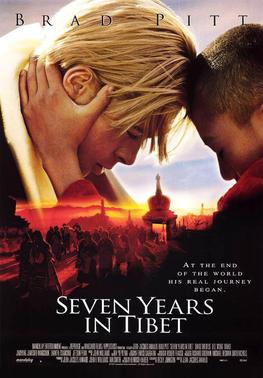
Seven Years in Tibet is a 1997 American biographical war drama film directed by Jean-Jacques Annaud. It is based on Austrian mountaineer and Schutzstaffel (SS) sergeant Heinrich Harrer's 1952 memoir of the same name, about his experiences in Tibet between 1944 and 1951. Seven Years in Tibet stars Brad Pitt and David Thewlis, and has music composed by John Williams with a feature performance by cellist Yo-Yo Ma.
This is a list of topics related to Tibet.

Tibetan Buddhist architecture, in the cultural regions of the Tibetan people, has been highly influenced by Nepal, China and India. For example, the Buddhist prayer wheel, along with two dragons, can be seen on nearly every temple in Tibet. Many of the houses and monasteries are typically built on elevated, sunny sites facing the south. Rocks, wood, cement and earth are the primary building materials. Flat roofs are built to conserve heat and multiple windows are constructed to let in the sunlight. Due to frequent earthquakes, walls are usually sloped inward at 10 degrees.
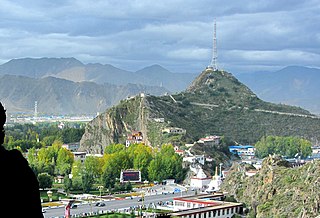
Chagpori, Chakpori, Chokpori, Chagpo Ri is a spirit-mountain of Vajrapani in Lhasa, Tibet. It is south of Potala and just to the left when one is facing the Potala. It is considered to be one of the four holy mountains of central Tibet.

Yatung or Yadong, also known as Shasima , is the principal town in the Chumbi Valley or Yadong County in the Tibet Autonomous Region of China. It is also its administrative headquarters.

Thomas Manning is considered the first lay Chinese studies scholar in Europe and was the first Englishman to enter Lhasa, the holy city of Tibet.

Lhasa is noted for its historic buildings and structures related to Tibetan Buddhism. Several major architectural works have been included as UNESCO's World Heritage Sites.
The Lhasa riot of 1750 or Lhasa uprising of 1750 took place in the Tibetan capital Lhasa, and lasted several days during the period of the Qing dynasty's patronage in Tibet. The uprising began on 11 November 1750 after the expected new regent of Tibet, Gyurme Namgyal, was assassinated by two Qing Manchu diplomats, or ambans. As a result, both ambans were murdered, and 51 Qing soldiers and 77 Chinese citizens were killed in the uprising. A year later the leader of the rebellion, Lobsang Trashi, and fourteen other rebels were executed by Qing officials.
Worried about its national interests after a 1903 British expedition, Qing China in 1910 sent a military force of 2,000 troops to Tibet, then its protectorate, to increase its authority in the region. This led to turmoil in Tibet, causing the Dalai Lama to flee to British India and a rupture in Sino-Tibetan relations.

The Ganden Phodrang or Ganden Podrang was the Tibetan system of government established by the 5th Dalai Lama in 1642, when the Oirat lord Güshi Khan who founded the Khoshut Khanate conferred all spiritual and political power in Tibet to him in a ceremony in Shigatse. During the ceremony, the Dalai Lama "made a proclamation declaring that Lhasa would be the capital of Tibet and the government of would be known as Gaden Phodrang" which eventually became the seat of the Gelug school's leadership authority. The Dalai Lama chose the name of his monastic residence at Drepung Monastery for the new Tibetan government's name: Ganden (དགའ་ལྡན), the Tibetan name for Tushita heaven, which, according to Buddhist cosmology, is where the future Buddha Maitreya resides; and Phodrang (ཕོ་བྲང), a palace, hall, or dwelling. Lhasa's Red Fort again became the capital building of Tibet, and the Ganden Phodrang operated there and adjacent to the Potala Palace until 1959.

The Convention of Lhasa, officially the Convention Between Great Britain and Thibet, was a treaty signed in 1904 between Tibet and Great Britain, in Lhasa, the capital of Tibet, then a protectorate of the Qing dynasty. It was signed following the British expedition to Tibet of 1903–1904, a military expedition led by Colonel Francis Younghusband, and was followed by the Anglo-Chinese Convention of 1906.























